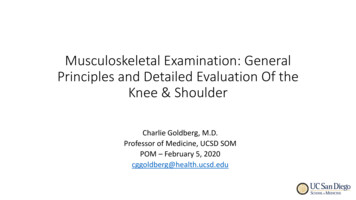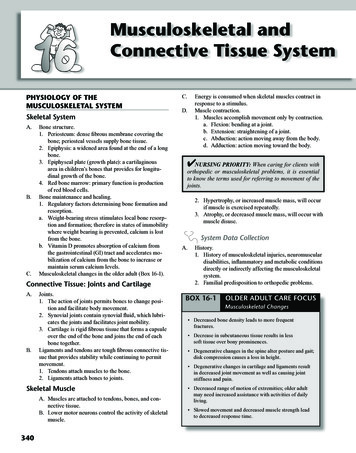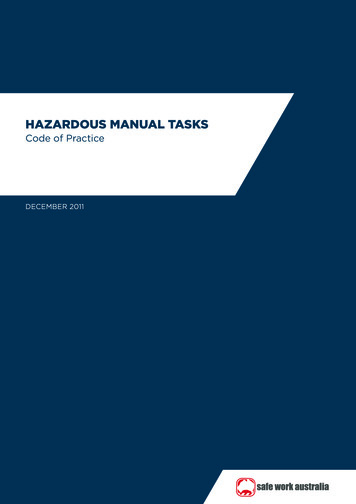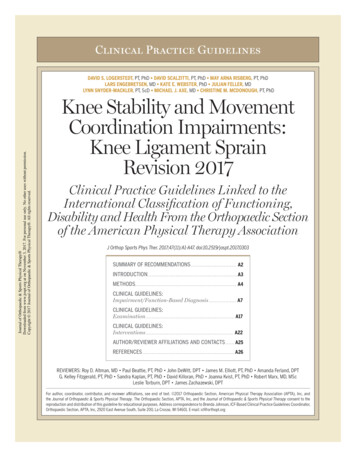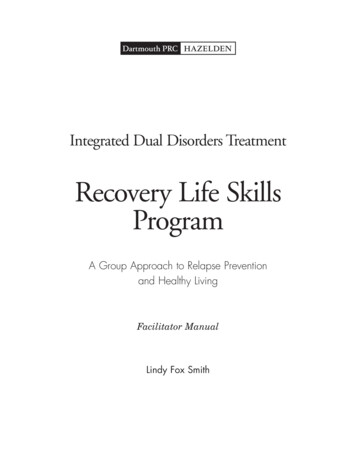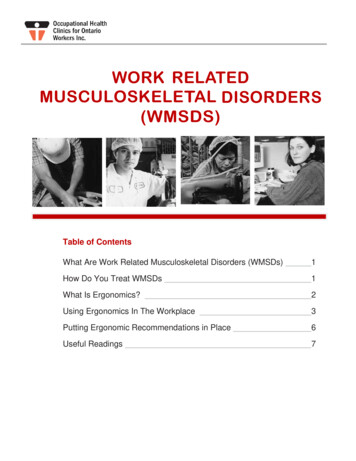
Transcription
WORK RELATEDMUSCULOSKELETAL DISORDERS(WMSDS)Table of ContentsWhat Are Work Related Musculoskeletal Disorders (WMSDs)1How Do You Treat WMSDs1What Is Ergonomics?2Using Ergonomics In The Workplace3Putting Ergonomic Recommendations in Place6Useful Readings7
W O R K R E L AT E D M U S C U L O S K E L E TA L D I S O R D E R S ( W M S D S )WHAT ARE WORK RELATED MUSCULOSKELETAL DISORDERS (WMSDs)?WHEN A MUSCLE, TENDON, NERVE OR JOINT IS STRESSED ANDTRAUMATIZED ON A REPEATED BASIS FOR DAYS, MONTHS OR YEARS,THOSE BODY TISSUES EVENTUALLY BECOME DAMAGED. This leads to a workrelated musculoskeletal disorder. Work related musculoskeletal disorders (WMSDs)are sometimes called repetitive strain injuries (RSIs), cumulative trauma disorders andoveruse injuries.When a WMSD develops, a worker experiences:1. Swelling, as some tissues become irritated2. Pain3. Stiffness and loss of range of motion of surrounding joints4. Inability to work and function at homeBesides the most common upper extremity disorders, WMSDs may also affect the lowback, knees, ankles and feet.HOW DO YOU TREAT WMSDs?Ergonomics should be a priority in the workplace, so WMSDs are prevented instead oftreated.If you think you have signs and symptoms of a repetitive strain injury, see your doctor.Make sure your doctor has a description of your job and understands how your jobaffects your body.Treatment may involve a combination ofapproaches such as: Job modifications Services of health professionals, such asphysiotherapists or massage therapists Exercise program Use of medication for pain relief Application of heat or coldOccupational Health Clinics for Ontario Workers1
W O R K R E L AT E D M U S C U L O S K E L E TA L D I S O R D E R S ( W M S D S )Table 1: Examples of common WMSDsDisease/ConditionTissue AffectedSymptomsPossible CausesCarpal tunnel syndromeoccurs on the palm side ofthe wristMedian nerveBlood vesselsTendonsRepetitive flexion of wristMyofascial pain in the neckand upper backMusclesTendonSometimes nervesNumbness/tingling affectingthe thumb, index, middle,and half of the ring fingers,especially at nightWeak gripHeavy feeling, aching painStiffness in upper back &neckPoor sleepShoulder bursitisBursa (lining of shoulderjoint)Shoulder painStiffnessProblems putting on sweaterRepeated shouldermovementsRotator cuff tendonitisRotator cuff tendon locatedin front of shoulderShoulder painStiffnessProblem reaching behind onupper backRepeated shouldermovement especially withtwistingOverhead throwingTennis elbow (lateralepicondylitisElbow tendon on thumb sideor armElbow painProblem wringing towel &carrying groceriesRepeated twisting armmovementThumb tendonitis orDeQuervain’s tendonitisTendon of thumb (from thenail to the wrist)Pain in thumbProblem with pinching &grippingRepeated pressing, pullingwith thumbTrigger fingers ortenosynovitis of fingersTendons, synovium (lining oftendons)Fingers “lock” and release by Repeated use of hand toolspushing on themor gripping motionsWrist/forearm tendonitisTendons, musclePain, swellingWeak gripWorking overheadArms in extended positionRepetitive movements ofwrists & forearmsYour treatment program should be planned by you and your doctor.WHAT IS ERGONOMICS?Ergonomics is defined as fitting the task, tools, materials and equipment in theworkplace to the worker. The goal of ergonomics is to reduce the risk of workersdeveloping repetitive strain injuries.Occupational Health Clinics for Ontario Workers2
W O R K R E L AT E D M U S C U L O S K E L E TA L D I S O R D E R S ( W M S D S )Workers are at risk of injury if they use repetitive, sustained, forceful, or awkwardexertions. Other risk factors are temperature, vibration, gloves, and contact pressure.If two or more risk factors are present, there is a greater risk of injury. For example,per forming a forceful lift once places a worker at less risk of injury than per forminga forceful lift several times per hour. Tables on the following pages identify severalergonomic risk factors and suggest ways to reduce the risk of injury.The risk of work related musculoskeletal disorders can be reduced by applyingergonomics principles. Workstation design, equipment and tools, work environment,and work organization are work components that affect ergonomic risk factors. Anergonomic design can include such factors as adjustable seating, angled handtools, or a work pace that can change to suit the worker.USING ERGONOMICS IN THE WORKPLACE:Does your workplace have any risk factors for repetitive strain injury?Use the following tables to help you identify some risk factors that may be present inyour workplace. Each table also identifies some general recommendations that maysuite you and your workstation. Investigate other ways to reduce ergonomic riskfactors at your job.Figure 2: To fit the job to the worker, you must consider work station design,equipment and tools, work organization and work NG THEJOB TO THEWORKEREquipment &ToolsWorkEnvironmentWorkstationDesignOccupational Health Clinics for Ontario Workers3
W O R K R E L AT E D M U S C U L O S K E L E TA L D I S O R D E R S ( W M S D S )Table 2: Workstation DesignErgonomic Risk FactorsPossible RecommendationsIs your chair uncomfortable?If you are required to sit, your chair should be adjustablefor height and angle and support your back.Change positions frequently.Do you have to twist or bend?Move equipment, parts, and papers closer to you. Storefrequently used equipment and parts slightly abovewaist height.Is lifting done above shoulder height?Work should be performed below shoulder height.Lower the work piece or use a platform to reduceworking above shoulder height (figure 3).Are your elbows raised while you work?Work heights should let you work with your elbows closeto your body; for example, light assembly work or typingshould be performed at elbow height.Is your worktable adjustable?If different people share a workstation, some heightadjustments is necessary to suit workers of differentheights.Do sharp edges put pressure on the skin?Round or pad edges of guards, containers orworktables.Express your concerns to the Joint Health & SafetyCommittee.Contact the Occupation Health Clinics for OntarioWorkers for more information.Do workers have pain or discomfort whiledoing their work?Figure 3: working with the arms above shoulderheight increased the risk of developing shoulderinjuries. Awkward postures can be reduced byraising the worker on a platform and/or loweringthe workpiece.Occupational Health Clinics for Ontario Workers4
W O R K R E L AT E D M U S C U L O S K E L E TA L D I S O R D E R S ( W M S D S )Ergonomic Risk FactorsPossible RecommendationsAre the tools heavy?Investigate redesigned tools that are lighter. Toolweight can be reduced with overhead tool balancers orsupports.Do tools/equipment vibrate?Investigate redesigned tools with less vibration. Refer tothe OHCOW handout entitled “Hand-Arm VibrationSyndrome”.Can anti-vibration gloves reduce vibrationexposure?Choose anti-vibration gloves that have been passedtechnical testing.Are awkward postures required whenusing tools/equipment?Tools can be purchased with bent handles designed toreduce awkward postures.Can the force required to use thetool/equipment be reduced?Select the right tool size for your hand. A textured toolis easier to grip than a smooth tool.Does the tool put pressure on the palm ofthe hand?Tools should have handles that do not end in the palmof the hand.Figure 4: By supporting the weight of the tool and reducingoverhead work, the risk of shoulder injury is reduced.Table 4: Work OrganizationErgonomic Risk FactorsPossible RecommendationsDo you do the same tasks over and over?Consider job rotation between jobs involving differentmovements and muscle groups. Consider adding avariety of tasks requiring different movements to arepetitive job (job enlargement).Is the work pace too fast?Reduce the pace of work. Take breaks that are longenough and frequent enough to allow recovery ofoverstressed parts.Is the training period adequate to educateworkers about safe performance of thetask?Workers should be trained about musculoskeletal injuryrisk factorsIs there a work hardening program?Persons returning from absence, work-related injury, orillness require an adjustment period.Occupational Health Clinics for Ontario Workers5
W O R K R E L AT E D M U S C U L O S K E L E TA L D I S O R D E R S ( W M S D S )Ergonomic Risk FactorsPossible RecommendationsAre workers included in job assessmentsand design or redesigns?From an Ergonomic Committee made up of worker andemployer representatives as a starting point for reducingmusculoskeletal injuries.Table 5: Work EnvironmentErgonomic Risk FactorsPossible RecommendationsDoes poor lighting lead to awkwardworking postures?Light levels that are too dim or too bright can lead toawkward postures. If your light levels are too bright ortoo dim, tell your Joint Health & Safety Committee.Is it too cold?Dress in several layers of clothing. Add and removeclothing as required.Is it too hot?Extra breaks may be required during times of extremeheat. Water should be readily available.Is your work or workplace stressful?Workplace stressors like lack of control, feelingoverworked, or low levels of job satisfaction canincrease the risk of developing musculoskeletal injuries.Clearly defined roles and responsibilities and goodcommunication are starting points for reducing stress atworkHow is the air quality?Air quality and ergonomic problems can both lead tohealth effects like headaches, fatigue, and musclesoreness.Is the workplace noisy?Investigate noise reduction methods.PUTTING ERGONOMIC RECOMMENDATIONS IN PLACEIf you have answered “yes” to the questions in Tables 2 to 5, there may be ergonomicproblems in your job design. Nobody knows you job and its problems better than you,the worker who performs the job daily. If you have concerns about your workstation orideas for improving the workstation design, tools, work organization, or workenvironment, tell your supervisor and Joint Health & Safety CommitteeRepresentatives.Ergonomists, occupational hygienists, nurses and doctors at the Occupational HealthClinics for Ontario Workers are available to help your Joint Health & Safety Committeesolve ergonomic problems.Occupational Health Clinics for Ontario Workers6
W O R K R E L AT E D M U S C U L O S K E L E TA L D I S O R D E R S ( W M S D S )USEFUL READINGS1. Canadian Standards Association (CSA) (2000). Office Ergonomics – A NationalStandard of Canada. CSA: Rexdale.2. Eastman Kodak Company (1983). Ergonomic Design for People at Work.Volume 1). Van Nostrand Reinhold: New York.3. Eastman Kodak Company (1986). Ergonomic Design for People at Work.(Volume 2). Van Nostrand Reinhold: New York.4. Konz., S. (1995). Work Design. Fourth Edition. Publishing Horizons, Inc.:Scottsdale.5. London Occupational Safety and Health Information Ser vices (LOSH) (1994).When Aches Become Injuries. (519)433-41566. Ministry of Labour (1992). Occupational Health and Safety Act. Ministry ofLabour: Toronto.7. Occupational Health Clinics for Ontario Workers (OHCOW) (2003). OfficeErgonomics Workbook.Occupational Health Clinics for Ontario Workers7
If you need further assistance, call the Occupational Health Clinic for Ontario Workers Inc. closest to you:Toll Free 1-877-817-0336SOUTH CENTRAL REGION – Hamilton848 Main Street EastHamilton, ON L8M 1L9(905) 549-2552Fax: (905) 549-7993E-mail: hamilton@ohcow.on.caEASTERN REGION—Ottawa1445 Carling Ave. Suite 101Ottawa, Ontario K1Z 8P9Tel 613.725.6999Fax 613.725.1719Email ottawa@ohcow.on.caSOUTH WESTERN REGION – SarniaLambton171 Kendall StreetPoint Edward, ON N7V 4G6(519) 337-4627Fax: (519) 337-9442E-mail: sarnia@ohcow.on.caNORTHERN REGION – Sudbury84 Cedar Street2nd FloorSudbury, ON P3E 1A5(705) 523-2330Fax: (705) 523-2606E-mail: sudbury@ohcow.on.caNORTH WESTERN REGION – Thunder Bay1151 Barton StreetSuite 103BThunder Bay, ON P7B 5N3(807) 623-3566Fax: (807) 622-5847E-mail: thunderbay@ohcow.on.caSOUTH WESTERN REGION – Windsor3129 Marentette AvenueUnit #1Windsor, ON N8X 4G1(519) 973-4800Fax: (519) 973-1906E-mail: windsor@ohcow.on.caCENTRAL REGION – Toronto970 Lawrence Ave. WestSuite 110Toronto, ON M6A 3B6(416) 449-0009Fax: (416) 449-7772E-mail: toronto@ohcow.on.caPROVINCIAL OFFICE#606 – 1090 Don Mills RoadToronto, ON M3C 3R6(416) 510-8713Fax: (416) 443-9132E-mail: ask@ohcow.on.caWebsite: http://www.ohcow.on.caFacebook: http://www.facebook.com/ohcowclinicsTwitter: http://twitter.com/#!/ohcowclinicsYoutube Channel: http://www.youtube.com/at6leeEvery effort has been made to ensure the accuracy of the information in this workbook. OHCOWassumes no responsibility for how this information is used.
Myofascial pain in the neck and upper back Muscles Tendon Sometimes nerves Heavy feeling, aching pain Stiffness in upper back & neck Poor sleep Working overhead Arms in extended position Shoulder bursitis Bursa (lining of shoulder joint) Shoulder pain Stiffness Problems putting on sweater Repeated shoulder movements

